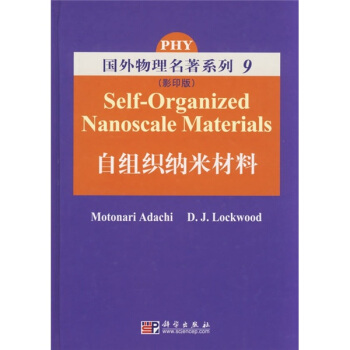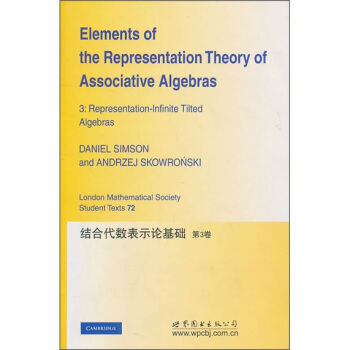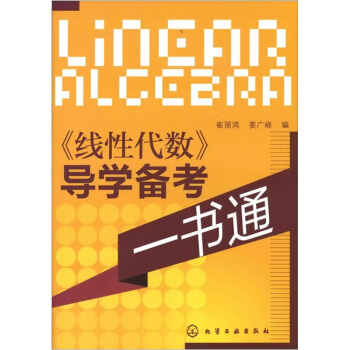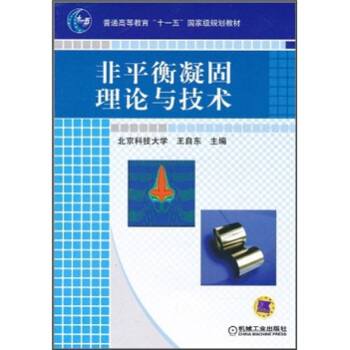

齣版社: 科學齣版社
ISBN:9787030187925
版次:1
商品編碼:10474752
包裝:精裝
叢書名: 國外物理名著係列(影印)
開本:16開
齣版時間:2007-04-01
用紙:膠版紙
頁數:317
字數:388000
正文語種:英文
具體描述
內容簡介
《自組織納米材料(影印版)》包含瞭大量通過化學、仿生學途徑並運用自組織機製閤成納米材料並産生不同尺度的組件的方法。過去的幾十年裏。納米結構新穎的係統性能在自然科學的各個領域中得到廣泛認可,新技術的不斷發展吸引瞭各個領域的科學傢投入到與之相關的研究中。要全麵實現納米科學與技術的巨大應用前景,麵臨的重要挑戰就是尋找在原子尺度上調製排列結構的方法以及構造原子、介觀、宏觀各尺度層次的材料。《自組織納米材料(影印版)》介紹瞭納米結構自組裝領域從基礎理論到相關應用的大量令人鼓舞的最新進展,可供物理學、化學、生物學、工程和材料科學領域中科研人員和研究生參考。目錄
Preface1、Self-Assembled Si1-xGex Dots and Islands
Jean-Marc Baribeau,Nelson L.Rowell,and David J.Lockwood
1.1 Introduction
1.2 Si1-xGex Island Growth
1.2.1 Growth Modes in Heteroepitaxy
1.2.2 Si1-xGex Island Growth and Shape Evolution
1.2.3 Si1-xGex Island Composition and Strain Distribution
1.3 Stacked Si1-xGex Islands
1.3.1 Development of Morphological Instabilities in Heteroepitaxy
1.3.2 Synthesis,Structure,and Vertical Correlation
1.3.3 Vibrational Properties
1.3.4 Optical Properties
1.4 Engineering of Si1-xGex Islands
1.4.1 Influence of Surface Morphology
1.4.2 Influence of Adsorbed Species
1.5 Applications of Si1-xGex Islands and Dots
1.5.1 Photodetectors
1.5.2 Other Applications
1.6 Summary and Future Prospects
References
2、Synthesis of Titania Nanoerystals: Application for Dye-Sensitized Solar Cells
Motonari Adachi,Yusuke Murata,Fumin Wang,and Jinting Jiu
2.1 Formation of Titania Nanocrystals by Surfactant-Assisted Methods
2.1.1 Introduction: How to Control Morphology and Functionalize Ceramic Materials
2.1.2 Formation of Network Structure of Single Crystalline TiO2 Nanowires by the "Oriented Attachment" Mechanism
2.1.3 Morphological Control of Anatase Nanocrystals Using Dodecanediamine as a Surfactant
2.2 Application of TiO2 Network of Single-Crystalline Nanowires for Dye-Sensitized Solar Cells
2.2.1 Introduction
2.2.2 How to Make the Dye-Sensitized Solar Cells
2.2.3 Characterization of the Solar Cells Made of Network of Single-Crystalline Anatase Exposing Mainly the {101} Plane
2.3 Summary
References
3、Soft Synthesis of Inorganic Nanorods,Nanowires,and Nanotubes
Shu-Hong Yu and Yi-Tai Qian
3.1 Introduction
3.2 An Overview: Emerging Synthetic Routes for the Synthesis of Low-Dimensional Nanocrystals
3.2.1 "Hard" Approaches
3.2.2 "Soft" Approaches
3.3 Soft Synthesis of Low-Dimensional Nanocrystals
3.3.1 Hydrothermal/Solvothermal Processes
3.3.2 Synthesis of Semiconductor Nanorods/Nanowires by Solution-Liquid-Solid Mechanism
3.3.3 Capping Agents/Surfactant-Assisted Soft Synthesis
3.3.4 Bio-Inspired Approach for Complex Superstructures
3.3.5 Oriented Attachment Growth Mechanism
3.4 Summary and Outlook
References
4、Assembly of Zeolites and Crystalline Molecular Sieves
Jennifer L.Anthony and Mark E.Davis
4.1 Introduction
4.2 Thermodynamics of Synthesis Processes
4.3 Kinetics of Synthesis Processes
4.4 Assembly Processes
4.4.1 Proposed Mechanisms for Zeolite Assembly
4.4.2 MetaMon-Assisted Assembly Processes
4.5 Components of Synthesis
4.5.1 Organic Components
4.5.2 Inorganic Components
4.6 Chirality:Can a Designer Zeohte Be Synthesized
4.7 Summary
References
5、Molecular Imprinting by the Surface Sol-Gel Process:Templated Nanoporous Metal Oxide Thin Films for Molecular Recognition
Seung-Woo Lee and Toyoki Kunitake
5.1 Introduction
5.2 Surface Sol-Gel Process
5.2.1 Preparation of Amorphous Metal Oxide Thin Films
5.2.2 Rich Variety of Organic Components in Nanohybrid Layers
5.3 Molecular Imprinting in Amorphous Metal Oxide Films
5.3.1 Incorporation and Removal of Templates
5.3.2 Stability and Selectivity of Imprinted Sites
5.3.3 Nature of Imprinted Sites for Guest Binding
5.3.4 Multifunctional Nature of Imprinted Cavity
5.3.5 Varied Molecular Selectivity
5.4 Practical Potentials
5.4.1 Recognition of Biological Molecules
5.4.2 Contrivance for High Sensitivity
5.4.3 Recognition of Coordination Geometry
5.4.4 Nanoporous Thin Films with Ion-Exchange Sites
5.4.5 Direct Observation of Imprinted Cavity-Physical Cavity Versus Topological Cavity
5.5 Unsolved Problems and Future Prospects
References
6、Fabrication,Characterization,and Applications of Template-Synthesized Nanotubes and Nanotube Membranes
Punit Kohli and Charles R.Martin
6.1 Introduction
6.2 Nomenclature
6.3 Template Synthesis of Nanotubes
6.4 Silica Nanotubes
6.4.1 Attaching Different Functional Groups to the Inside Versus Outside Surfaces
6.4.2 Nanotubes for Chemical and Bioextraction and Biocatalysis:Demonstration of Potential Drug Detoxification Using Nanotubes
6.5 Template Synthesis of Nano Test Tubes
6.6 Nanotube Membranes for Bioseparations
6.6.1 Antibody-Functionalized Nanotube Membranes for Selective Enantiomeric Separations
6.6.2 Functionalized Nanotube Membranes with "Hairpin"-DNA Transporter with Single-Base Mismatch Selectivity
6.7 Conical Nanotubes: Mimicking Artificial Ion Channel
6.8 Conclusions
References
7、Synthesis and Characterization of Core-Shell Structured Metals
Tetsu Yonezawa
7.1 Introduction
7.2 Preparation of Core-Shell Bimetallic Nanoparticles
7.2.1 Preparation Procedures
7.2.2 Successive Reduction of the Corresponding Two Metal Ions
7.2.3 Simultaneous Reduction of the Corresponding Two Metal Ions
7.2.4 Other Systems
7.3 Characterization of Core-Shell Bimetallic Nanoparticles
7.3.1 X-ray Characterization
7.3.2 Electron Microscopic Observations
7.3.3 UV-vis Spectroscopy
7.3.4 IR Spectroscopy of Chemical Probes
7.4 Summary
References
8、Cobalt Nanocrystals Organized in Mesoseopie Scale
Marie-Paule Pileni
8.1 Introduction
8.2 Self-Organization of Cobalt Nanocrystals
8.3 Collective Magnetic Properties of Mesostructures Made of Magnetic Nanocrystals
8.4 Conclusion
References
9、Synthesis and Applications of Highly Ordered Anodic Porous Alumina
Hideki Masuda and Kazuyuki Nishio
9.1 Introduction
9.2 Synthesis of Highly Ordered Anodic Porous Alumina
9.2.1 Growth of Anodic Porous Alumina on Al
9.2.2 Synthesis of Highly Ordered Anodic Porous Alumina
9.2.3 Ideally Ordered Anodic Porous Alumina by the Pretexturing Process Using Molds
9.3 Ordered Nanostructures Based on Highly Ordered Anodic Porous Alumina
9.3.1 Nanocomposite Structures Using Highly Ordered Anodic Porous Alumina
9.3.2 Nanofabrication Using Anodic Porous Alumina Masks
9.3.3 Two-Step Replication Process for Functional Nanohole Arrays
9.3.4 Ordered Array of Biomolecules Using Highly Ordered Anodic Porous Alumina
9.4 Conclusions
References
Index
前言/序言
用戶評價
評分
恩,挺不錯的,挺專業的
評分不錯不錯不錯不錯不錯
評分恩,挺不錯的,挺專業的
評分恩,挺不錯的,挺專業的
評分不錯不錯不錯不錯不錯
評分不錯不錯不錯不錯不錯
評分有一點是質量一般,殼子不知道什麼時候會掉掉
評分恩,挺不錯的,挺專業的
評分恩,挺不錯的,挺專業的
相關圖書
本站所有內容均為互聯網搜尋引擎提供的公開搜索信息,本站不存儲任何數據與內容,任何內容與數據均與本站無關,如有需要請聯繫相關搜索引擎包括但不限於百度,google,bing,sogou 等
© 2025 windowsfront.com All Rights Reserved. 靜流書站 版權所有





![Springer數學經典教材:經典巴拿赫空間1和2 [Classical Banach Spaces 1 and 2] pdf epub mobi 電子書 下載](https://pic.windowsfront.com/10562555/69027d63-0cb6-40dc-8ec4-5b076a9ec8ac.jpg)














